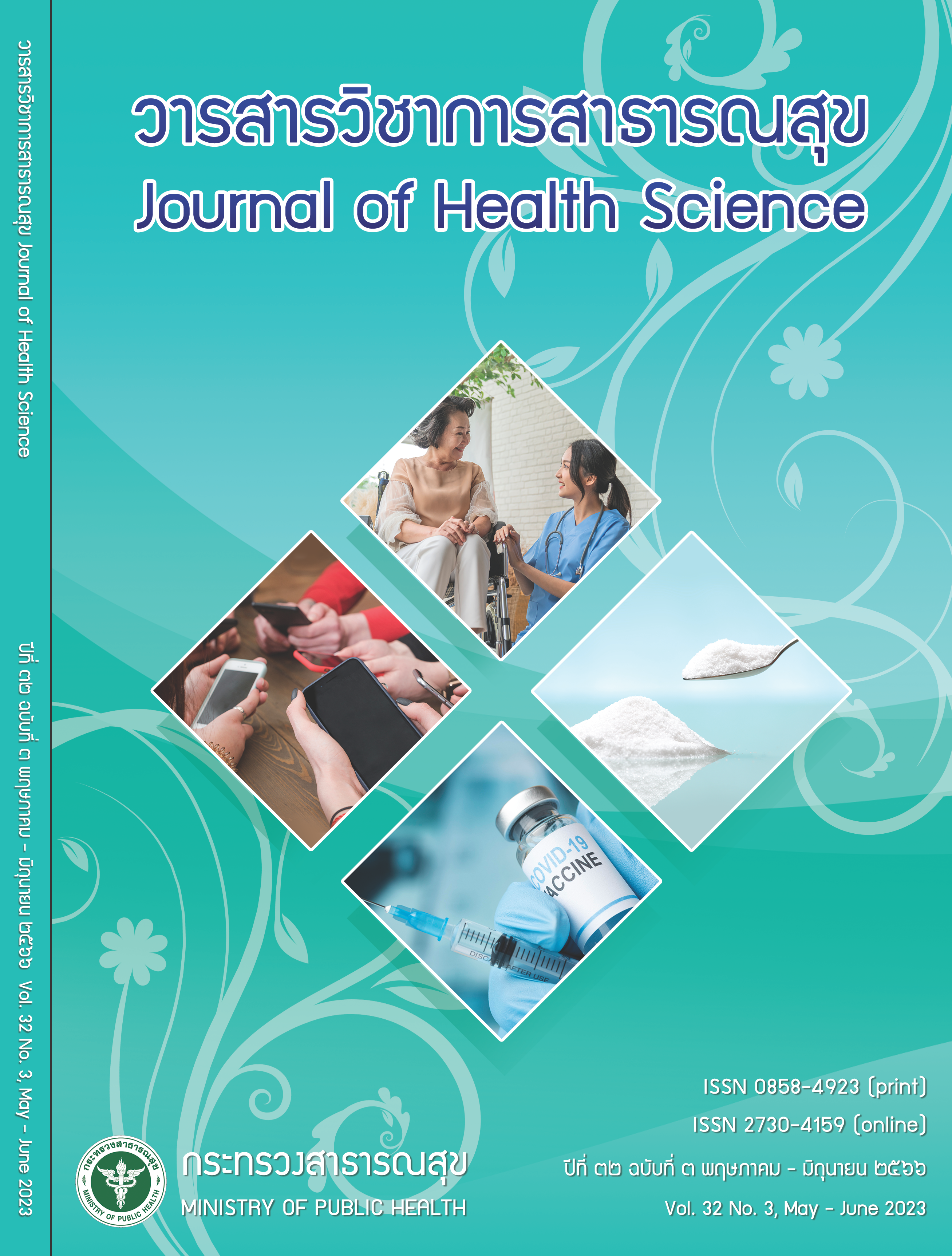Development of the Benign Paroxysmal Positional Vertigo (Bppv) Assessment and Treatment Algorithm: the Trang Model
Keywords:
physical therapy, vestibular rehabilitation, benign paroxysmal positional vertigoAbstract
Benign paroxysmal positional vertigo (BPPV) caused by dislodged inner ear otoliths is the most common cause of vertigo symptoms characterized by spinning sensations. Currently, there is no clear treatment guideline available for this condition. Therefore, the Physical Therapy Department at Trang Hospital has developed a rehabilitation guideline to improve the functional capacity of patients with BPPV using the Trang model approach and clinical outcome measures. The objective of this study was to investigate the effects of implementing this rehabilitation guideline on the clinical outcomes and reduction of vertigo symptoms. The study utilized a retrospective data review of BPPV patients who received treatment at Trang Hospital’s clinic between the years 2016 and 2021, with a total of 1,032 cases. The results demonstrated that the implementation of the new rehabilitation guideline significantly increased the number of patient discharges within five treatment sessions. The average number of visits per patient increased from 1.01 to 1.71 between the years 2020 and 2021, respectively. Moreover, patient satisfaction also showed a significant improvement. In conclusion, this study found that the development of a rehabilitation guideline for BPPV using the Trang model approach resulted in improved clinical outcomes compared to the pre-guideline period.
Downloads
References
ปารยะ อาศนะเสน. โรคตะกอนหินปูนในหูชั้นในหลุด [อินเทอร์เน็ต]. 2554 [สืบค้นเมื่อ 22 ส.ค. 2565]. แหล่งข้อมูล: https://www.si.mahidol.ac.th/th/healthdetail. asp?aid=901
Hall CD, Herdman SJ, Whitney SL, Cass SP, Clendaniel RA, Fife TD, et al. Vestibular rehabilitation for peripheral vestibular hypofunction: an evidence-based clinical practice guideline: from the American physical therapy association neurology section. J Neurol Phys Ther 2016;40(2):124-55.
Deming WE. Out of the crisis. Cambridge, MA: MIT Press; 1986.
วัชรินทร์ ทายะติ. การให้บริการการฟื้นฟูสมรรถภาพการ ทรงตัวผู้ป่วยโรคหินปูนในหูชั้นในหลุด คลินิกลดเวียนศีรษะ งานกายภาพบำบัด โรงพยาบาลศูนย์ตรัง (BPPV assessment and treatment algorithm: Trang model) [อินเทอร์เน็ต]. 2021 [สืบค้นเมื่อ 22 ส.ค. 2565]. แหล่งข้อมูล: http:// www.tranghos.go.th/index.php/2019-06-26-09-38- 44/1239-2021-11-25-04-36-22
Hizal E, Jafarov S, Erbek SH, Ozluoglu LN. Clinical interpretation of positional nystagmus provoked by both Dix-Hallpike and supine head-roll tests. J Int Adv Otol [Internet]. 2022 [cited 2022 Aug 22];18(4):334–9. Available from: http://dx.doi.org/10.5152/iao.2022. 21461
Chen PY, Jheng YC, Huang SE, Li PH, Wei SH, Schubert MC, et al. Gaze Shift Dynamic Visual Acuity: A Functional test of gaze stability that distinguishes unilateral vestibular hypofunction. J Vestib Res. 2021[cited 2022 Aug 22];31(1):23-32. Available from: http://dx.doi. org/10.3233/VES-201506
Lee JY, Lee IB, Kim MB. Correlation between residual dizziness and modified clinical test of sensory integration and balance in patients with benign paroxysmal positional vertigo. Res Vestib Sci [Internet]. 2021[cited 2022 Aug 22];20(3):93–100. Available from: http://dx.doi. org/10.21790/rvs.2021.20.3.93
Cohen HS, Gottshall KR, Graziano M, Malmstrom EM, Sharpe MH, Whitney SL, et al. International guidelines for education in vestibular rehabilitation therapy. J Vestib Res [Internet]. 2011[cited 2022 Aug 22];21(5):243– 50. Available from: http://dx.doi.org/10.3233/VES2011-0424
Plus by Physiopedia. Plus instructor Bernard Tonks [Internet]. Physio-pedia.com. [cited 2022 Aug 22]. Available from: https://members.physio-pedia.com/instructor/bernard-tonks/
Horak FB. Postural orientation and equilibrium: what do we need to know about neural control of balance to prevent falls? Age and Ageing [Internet]. 2006[cited 2022 Aug 22];35(suppl_2):ii7-ii11. Available from: https:// academic.oup.com/ageing/article/35/suppl_2/ ii7/15654
Gaerlan M, Alpert PT, Cross C, Louis M, Kowalski S. Postural balance in young adults: the role of visual, vestibular and somatosensory systems. J Am Acad Nurse Pract [Internet]. 2012[cited 2022 Aug 22];24(6):375– 81. Available from: http://dx.doi.org/10.1111/j.1745- 7599.2012.00699.x
Chen Y, Zheng J, Wu D, Zhang Y, Lin Y. Application of the PDCA cycle for standardized nursing management in a COVID-19 intensive care unit. Ann Palliat Med [Internet]. 2020 [cited 2022 Aug 22];9(3):1198–205. Available from: https://apm.amegroups.com/article/ view/43455/html
Bhattacharyya N, Gubbels SP, Schwartz SR, Edlow JA, El-Kashlan H, Fife T, et al. Clinical practice guideline: benign paroxysmal positional vertigo (update). Otolaryngol Head Neck Surg [Internet]. 2017[cited 2022 Aug 22];156(3_suppl):S1–47. Available from: http://dx. doi.org/10.1177/0194599816689667
Foster A, Croot L, Brazier J, Harris J, O’Cathain A. The facilitators and barriers to implementing patient reported outcome measures in organisations delivering health related services: a systematic review of reviews. J Patient Rep Outcomes [Internet]. 2018 [cited 2022 Aug 22];2(1):46. Available from: http://dx.doi.org/10. 1186/s41687-018-0072-3
Downloads
Published
How to Cite
Issue
Section
License

This work is licensed under a Creative Commons Attribution-NonCommercial-NoDerivatives 4.0 International License.







